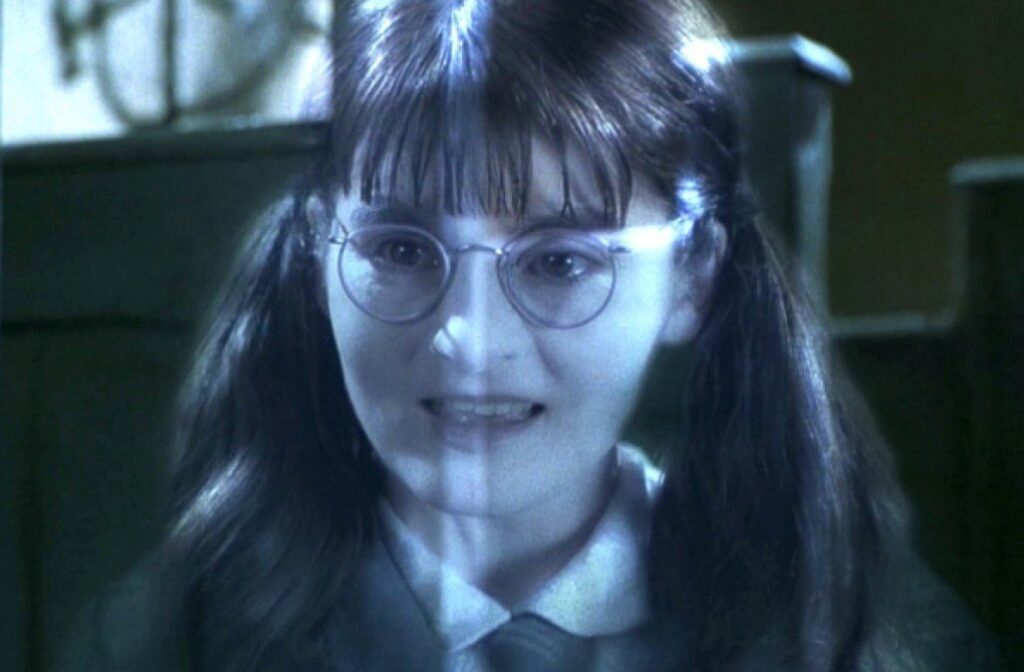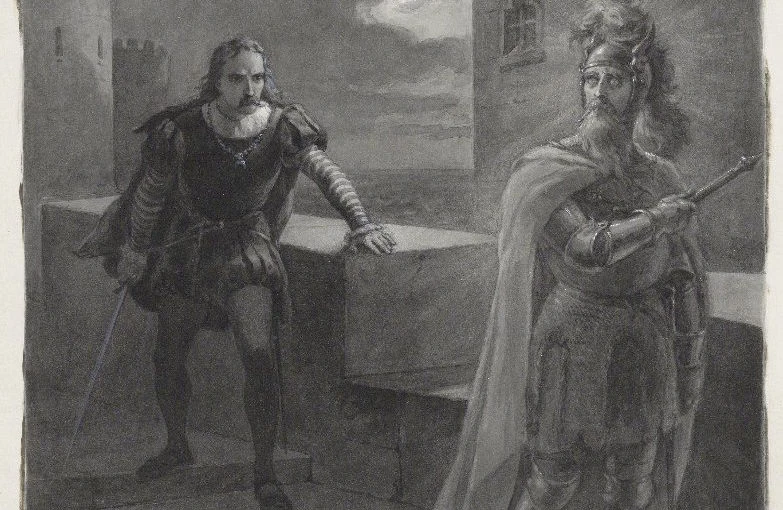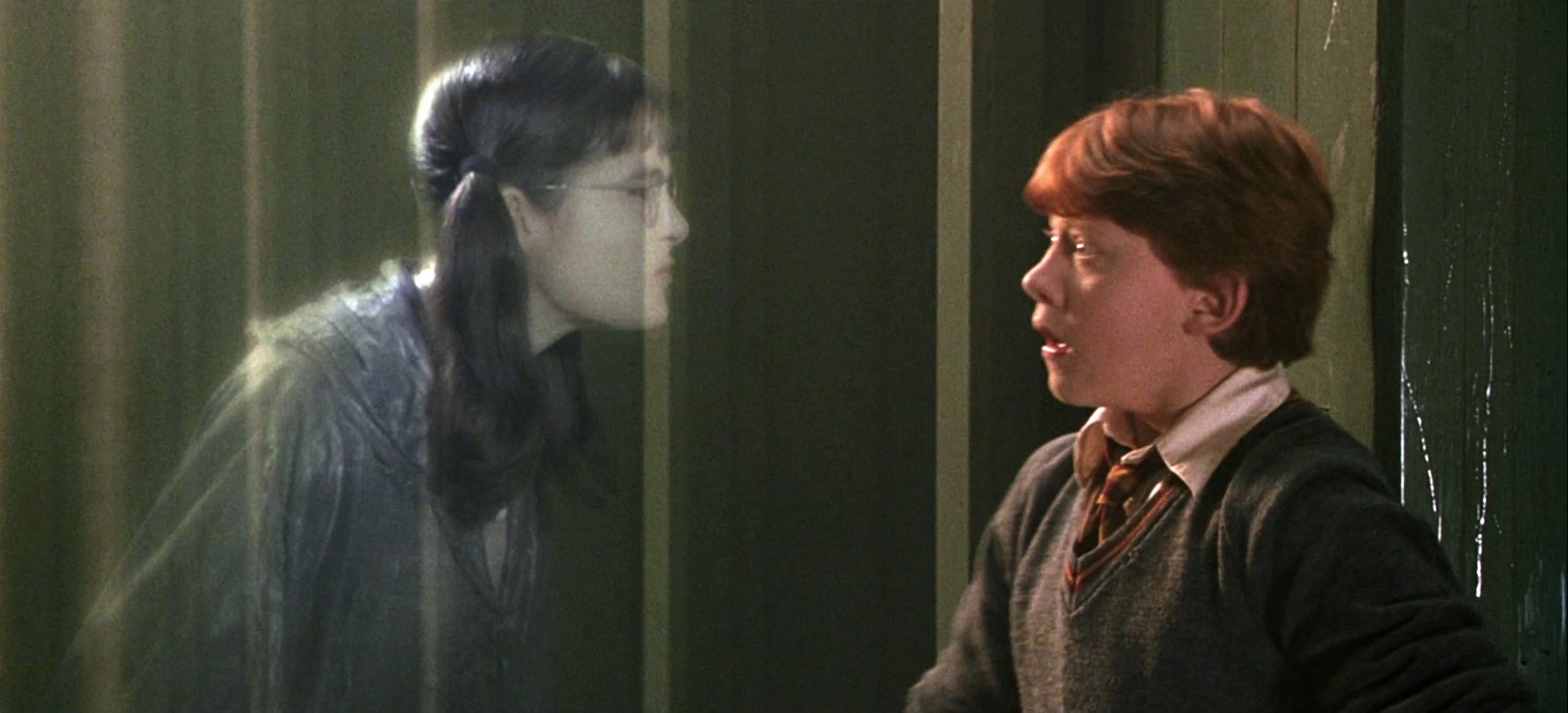Halloween might be over, but the spritely fun around it still lives. Our author, here, looks into two popular ghosts in literature – Moaning Myrtle and Hamlet’s Father – and analyses their popularity and significance in pop culture.
Ghosts and spirits have long captivated the human imagination. In all forms of media – literature, magazines, television, movies. They haunt our stories, have been passed down in folklore, and populate our everyday media consumption. What is it about these apparitions that continue to enchant us, generation after generation? In this essay, let’s find out by exploring two of the most popular ghosts in literature – Moaning Myrtle from J.K. Rowling’s Harry Potter series and the ghost of Hamlet’s father from William Shakespeare’s timeless tragedy, Hamlet.
Moaning Myrtle: Harry Potter Series

In the enchanting world of Harry Potter, amid the grandeur of Hogwarts School of Witchcraft and Wizardry, there exists a ghostly presence that stands out for her peculiar charm, or rather, the lack of charm and multitude of peculiar. A teenage ghost with a penchant for everything gloomy, and an unmistakable flair for the melodramatic, Myrtle Warren is an unforgettable ghost in this magical world.
A translucent figure, similar in appearance to other ghosts in the Harry Potter world, she is shown to have lank, dripping hair, thick glasses perched pretty precariously on her nose, and a distant, despondent expression that could dampen even the sunniest of days – not that she can, however, as she lives in the abandoned second-floor girls’ bathroom of the Hogwarts castle.
Myrtle’s appearance reflects her tragic past, revealed in the second instalment, Harry Potter and the Chamber of Secrets. She is a teenager petrified by the unyielding gaze of a basilisk, a mammoth-size snake-like magical creature lurking in the Chamber of Secrets. In life, Myrtle was not only a casualty of Voldemort’s sinister plans but also a victim of the social interactions within the school that plagued her existence. Long before her death, she endured relentless bullying from other students – based on her appearance mainly – and struggled to find acceptance among her peers. Her spirit, forever marked to appear as an adolescent, underscores the unfairness of her untimely departure from the living world.
Apart from her appearance, what majorly sets Myrtle apart is her personality – she is the quintessential gripe, caught forever in her never-ending lament. She is known to wail and fret about things constantly, and has a tendency to wallow in self-pity, earning her much-deserved title of “Moaning” Myrtle. On top of this, she seems to take great sadistic pleasure in other people’s downfalls, especially Hermione’s [when her Polyjuice Potion makeover goes horribly wrong, for example], and tends to follow Harry with the charm of a wooden tablespoon. To spend time with Myrtle in the girls’ bathroom is to be treated with a symphony of sighs, groans, and melodramatic outbursts. And therein lies the charm, or the bewitching peculiarity of who Myrtle is.
Her dialogues are often preoccupied with her own death and are marked by squeamish, screeching flashes of shouting.
Myrtle: Here I am, minding my own business, and someone thinks it’s funny to throw a book at me.
Harry: But, it can’t hurt if someone throws something at you. I mean, it would just go right through you.
Myrtle: Sure! Let’s all throw books at Myrtle, because she can’t feel it! Ten points if you get it through her stomach! Fifty points if it goes through her head!
In the world of Harry Potter, Moaning Myrtle emerges as yet another character whose origin and being itself are related directly to magic, but her personality and characteristics make her extremely relatable in our mortal world – her eternal struggle with trying to find acceptance from her peers, remains eternal as she encounters adolescents after adolescents within the school, many of them making fun of her even as a ghost. With all her gloomy charm, she ends up playing a pivotal role in multiple storylines and being an odd yet endearing character throughout.
Related to the Harry Potter series: 7 Themes and Life Lessons in the Harry Potter Books
Ghost of Hamlet’s father

In William Shakespeare’s Hamlet, a classic play considered to be one of the greatest works by one of the greatest writers, the ghost itself is a short-lived character, but its impact is pivotal to the plot. The ghost of Hamlet’s father, clad in armour and bearing the weight of unavenged murder, serves as a monumental character whose mere presence catalyses an entire chain of events, affecting the courses of the story and claiming its place as a quintessential Shakespeare play.
The ghost makes a dramatic entrance in the play, likely of a typical Shakespeare character, haunting the castle of Elsinore in the story. Shrouded in the aura of solemnity, he cuts a formidable and imposing presence. His appearance serves as a stark contrast to the remaining, living and breathing characters of the play, conveying the gravity of his purpose, and the dark secrets surrounding his murder. It creates an atmosphere of fear and foreboding, his armour symbolising the battles he fought in his life and also the ongoing struggle for revenge, or justice, in his death. This sets the tone for vengeance that is overcast in the remainder of the play.
Defined by a sense of duty, and a relentless desire for retribution, Hamlet’s father’s ghost carries with him the emotional weight and mystery of an unnatural and unavenged death. He becomes a sympathetic figure in the eyes of the audience, having been wronged both in life and in death, by loved ones in either case. He is a haunting avenger, driven by the need to expose the treachery done unto him and the royal family, and the desire that his son seek revenge on his behalf, and continue his lost legacy. His dialogues are also fraught with emotion and meaning, imploring Hamlet to “revenge” his “foul and most unnatural murder”.
The ghost’s revelation about his murder sets the path for Hamlet in retribution and, in turn, the entire storyline. This ignites a chain of events that leads to deception, madness, and the ultimate tragedy. It forces Hamlet to come to terms with questions of morality, justice, and the consequences of your own actions. Although the ghost appears only four times in the entire play, he acts as the harbinger of justice, the decider of destinies, and the trigger for what follows.
Conclusion
Both the ghosts of Moaning Myrtle and Hamlet’s father present striking visual contrasts, but each is loaded with symbolism. While Myrtle captures the essence of teenage innocence frozen over aeons, the Ghost encapsulates the battles he fought and continues to fight in life and death. Myrtle is youthful, with a fragile, ethereal quality, while the ghost stands as a stoic and intimidating figure.
Much of Myrtle’s appearances in the seven-part series are loosely tied to those of a background character – incessantly present but rarely part of the plot device. She plays a pivotal role in the second book but otherwise continues to navigate the loneliness of her ghastly existence. The Ghost, on the other hand, exudes all seriousness, and his motivation is the pursuit of justice and exposure of treachery within the royal family. While Myrtle’s existence largely hangs on for emotional validation, Hamlet’s father’s ghost comes into the picture purely for revenge. While they are not the only reasons why ghosts are introduced in popular literature, these are simply two ways in which these spiritual beings are captured in the realm of literature, amongst the myriad storylines written by countless other authors. Irrespective of their roles in a story, ghosts continue and will continue to be an integral part of the fictional world, capturing readers’ imaginations and defying scientific logic, while at times adhering to humanitarian laws.


